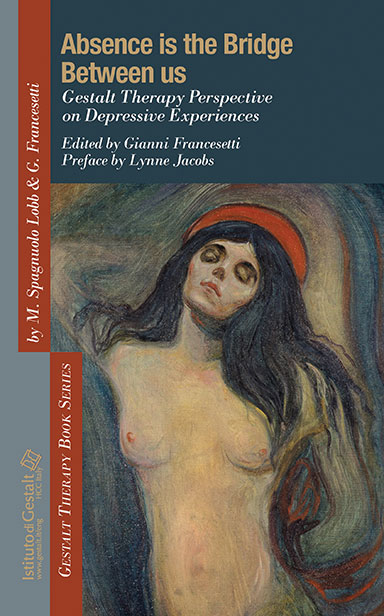
Absence is the Bridge
between us
Gestalt Therapy Perspective on Depressive Experiences
Edited by Gianni Francesetti
Preface by Lynne Jacobs
Back Cover
“I am grateful for what I have learned from reading this book. Each author demonstrates that depressive experiences are field phenomena, contextually emergent and contextually supported, and affecting our environment. They are not isolated events, they are of a field. They emerge from contexts that support depressive experiences. The impoverished conditions ‘speak’ through the person who presents with depression.
The perspective this book offers gave me a more nuanced appreciation of the many experiences with depression that my patients and I have lived through. The foundational, even existential significance is clearer to me now. Our perseverance and emotional courage have been cast in a more profound light, which inspires my current work.
The combination of clinical insight and theoretical inspiration is breathtaking.”
From the Preface by Lynne Jacobs
Buy now
Discounted book price: 39 Euro
Contents
Preface, by Lynne Jacobs
Introduction
Acknowledgements
- Gestalt Therapy Perspective on Depressive Experiences: An Introduction 1. Depressive Experiences Amidst Human Experiences 1.1. The Projection Towards the Future as an Ontological Condition of the Human Being: Now-for-Next and Depression 1.2. Depression as Inability to Trascend Oneself 2. Depressive (and Manic) Experiences in the Epistemology of Gestalt Therapy and Psychiatry 2.1. Depressive Contact as a Symphony of Domains 2.2. Reactive Depression 2.3. Embodied Depression 2.4. The Psychotic Depressive Experience 2.5. Manic Experiences 3. A Phenomenological and Aesthetic Reading of Depressive Experiences in Psychotherapy: Depressive Experiences as Availability of the Patient Towards the Contact with the Therapist 3.1. The Therapeutic Dance Between Excitement and Support 3.2. The Advantages of Gestalt Work with Depressive Experiences 4. The Relational Void in Our Society: the Now-for-Next of Gestalt Therapy 4.1. Juvenile Depression: Not Being in One’s Life and Body 4.2. Depression and Intentionality of Contact 4.3. Two Clinical Illustrations 4.4. The Future of Gestalt Clinical Practice 4.5. My Own Music for Depressive Experiences. References
- Phenomenology and a Gestalt Therapy Approach to Depressive Experiences 1. A Brief History of Diagnosis: the Construction and Deconstruction of Depression as an Object 2. Depressive Experiences: a Gestalt Therapy Approach 2.1. The Figure/Background Dynamic 2.2. Intentionality in Depressive Experiences 2.3. The Self and Its Functions in Depression 2.4. The Issue of the Biological Component of Melancholic Depression 2.5. Depressive Experiences as Creative Adjustment 2.6. Transgenerational Transmission of the Depressive Fields
3. Psychotherapy and Psychopharmacology. References
- Some Gestalten of Depressive Experiences 1. The Presence of Absence: Mourning and Reactive Depressive Fields 1.1. The Work of Mourning 1.2. Reactive Depression 2. The Absence of Presence: Melancholic Field
2.1. The Start of Therapy 2.2. Two Horizons of Therapy 2.2.1. The First Therapeutic Horizon 2.2.2. The Second Therapeutic Horizon 2.3. Therapist’s Feelings in a Depressive Field 2.4. Being Present on the Brink of the Abyss
2.5. The Topic of Aggressiveness 2.6. Some Elements of Specific Support 2.6.1. Apprehending. Naming and Defininf Experiences (Rather than Amplifying Them) 2.6.2. Mobilizing Energy 3. Depressive Experiences in Different Relational Styles 3.1. Narcissistic Experiences 3.2. Borderline Experiences 3.3. Dependent Experiences 3.4. Hysterical Experiences 3.5. Obsessive-Compulsive Experiences 4. Depressive Experiences from Identifiable Organic Causes. References
- Depressing Together. Therapist’s Experience in a Therapy Situation with a Depressed Client 1. Introduction
2. Co-Creating Depression 3. Therapist Experience 3.1. Depression Co-Experiencing Trajectory 3.2. Why Are Therapists Unable To Learn from their Previous Experience? 4. Implications for Clinical Practice 5. Conclusion: Compassion to Oneself. References
- A Journey to Motherhood. Postpartum Depressive Experiences 1. Symptoms and Clinical Diagnosis 2. Difficulties in PPD Diagnostics: the Silence of Women 2.1. Postpartum Depression Consequences 2.2. Psychological Content of Postpartum Depression 2.3. The Phenomenology of Postpartum Depression 2.4. Journey to Motherhood 2.5. Pregnancy and Self Process 2.6. Self Process in Postpartum Period 3. Therapeutic Support. References
- When Support Is Lacking. Childhood and Depressive Experiences 1. Semiology of Depression 1.1. When Clinical Practice Teaches Us 1.2. Whose Depression Is It? 2. A Gestalt Therapist’s Outlook 3. A Necessary Depressive Moment 4. The Child in His Family Environment 5. The Therapeutic Work in Gestalt Therapy: Mobilizing Resources 6. Towards a Therapeutic Methodology 7. Conclusion. References
- Walking a Tightrope. Depressive Experiences in Adolescence 1. The Adolescent’s Family and Cultural Background 2. Depressive Experiences Over the Life Cycle 3. Studies of Depressive Experiences in Adolescence 4. Intentionality for Contact and the Unreachableness of the Other in Adolescence 5. “Depressive Forms” in Adolescence: Self Functions and Phenomenological Understanding 6. Borderline and Narcissistic Elements in the Adolescent’s Depressive Experience 7. The Fine Line Between “Physiology” and Psychopathological Risk. Elements of Specific Support 8. Clinical Work. Viola’s Story 8.1. The Therapist’s Narrative 8.2. Viola’s Narrative 8.3. After the Storm. References
- Depressive Experiences in Old Age 1. Depression as a Creative Adjustment, a Response to the Situation
1.1. Depression as a Response to Recent Losses 1.2. Depression as a Response to Life 1.3. Depression as a Response to “Getting Older” and Facing Death 2. Psychotherapy in Old Age 2.1. Possible Approaches 3. Possible Other Psychological Interventions 3.1. Reminiscence 3.2. Validation 4. Cultural Aspects in Depression.
References
- Beyond the Familiar: Manic Experiences, Love and Genius at the Edges of the Contact Boundary Part 1. More than Pathology 1. Introduction: Historical Considerations and the Complexity of Definitions 2. Relational Intentionality in the Manic Experience 3. Introjects and Mood Swings 4. Time, Body and Vital Rhythms in Mania
- Going Further 6. Falling in Love 7. Stepping Out if Culture: Man in Front of the Void 8. Genius Part 2. Re-Thinking Mania as a Tool to Revise Some Gestalt Concepts. References
Authors
Gianni FRANCESETTI Gestalt therapist, psychiatrist, international trainer and supervisor. Coordinator of the International Training Program and Director of the Master on Gestalt Therapy Approach to Psychopathology (Istituto di Gestalt HCC Italy). President of the European Association for Psychotherapy, Past President of the Italian Federation of Psychotherapy Associations and of the Italian Society for Gestalt Therapy, member of the New York Institute for Gestalt Therapy, of the Association for the Advancement of Gestalt Therapy and of the Society for Psychotherapy Research. He lives and works in Turin (Italy) as psychotherapist, psychiatrist and supervisor.

